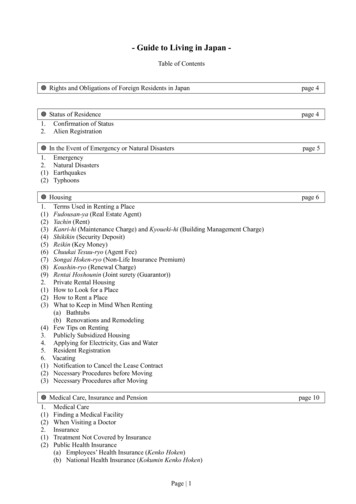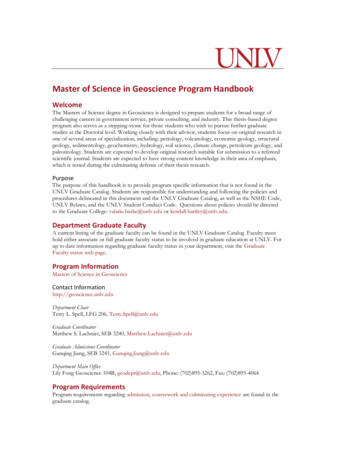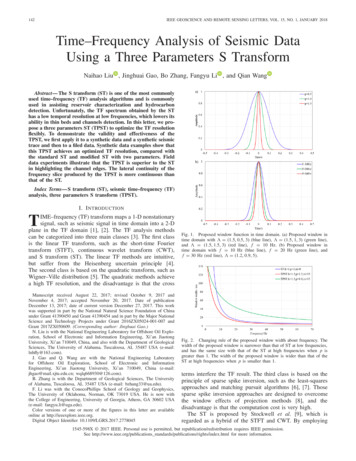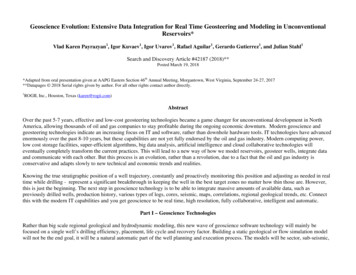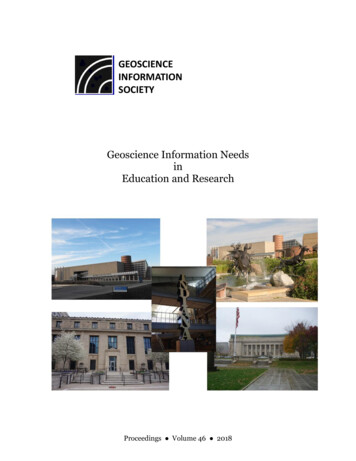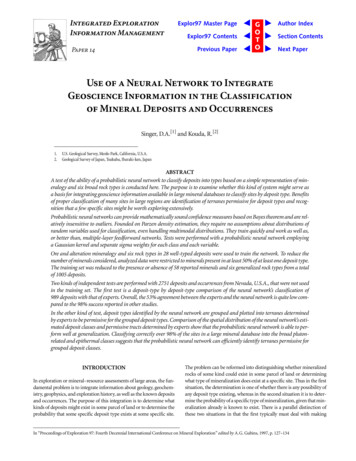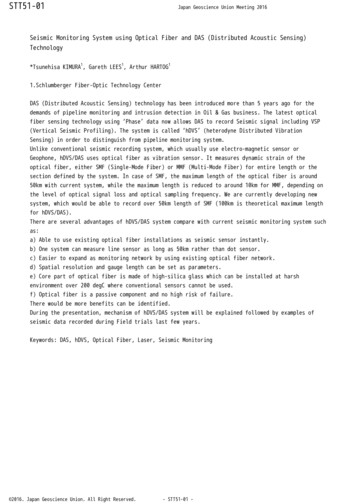
Transcription
STT51-01Japan Geoscience Union Meeting 2016Seismic Monitoring System using Optical Fiber and DAS (Distributed Acoustic Sensing)Technology*Tsunehisa KIMURA1, Gareth LEES1, Arthur HARTOG11.Schlumberger Fiber-Optic Technology CenterDAS (Distributed Acoustic Sensing) technology has been introduced more than 5 years ago for thedemands of pipeline monitoring and intrusion detection in Oil & Gas business. The latest opticalfiber sensing technology using ‘Phase’ data now allows DAS to record Seismic signal including VSP(Vertical Seismic Profiling). The system is called ‘hDVS’ (heterodyne Distributed VibrationSensing) in order to distinguish from pipeline monitoring system.Unlike conventional seismic recording system, which usually use electro-magnetic sensor orGeophone, hDVS/DAS uses optical fiber as vibration sensor. It measures dynamic strain of theoptical fiber, either SMF (Single-Mode Fiber) or MMF (Multi-Mode Fiber) for entire length or thesection defined by the system. In case of SMF, the maximum length of the optical fiber is around50km with current system, while the maximum length is reduced to around 10km for MMF, depending onthe level of optical signal loss and optical sampling frequency. We are currently developing newsystem, which would be able to record over 50km length of SMF (100km is theoretical maximum lengthfor hDVS/DAS).There are several advantages of hDVS/DAS system compare with current seismic monitoring system suchas:a) Able to use existing optical fiber installations as seismic sensor instantly.b) One system can measure line sensor as long as 50km rather than dot sensor.c) Easier to expand as monitoring network by using existing optical fiber network.d) Spatial resolution and gauge length can be set as parameters.e) Core part of optical fiber is made of high-silica glass which can be installed at harshenvironment over 200 degC where conventional sensors cannot be used.f) Optical fiber is a passive component and no high risk of failure.There would be more benefits can be identified.During the presentation, mechanism of hDVS/DAS system will be explained followed by examples ofseismic data recorded during Field trials last few years.Keywords: DAS, hDVS, Optical Fiber, Laser, Seismic Monitoring 2016. Japan Geoscience Union. All Right Reserved.- STT51-01 -
STT51-02Japan Geoscience Union Meeting 2016Seismic velocity change in Tokai region detected by Morimachi ACROSS*Shuhei Tsuji1, Koshun Yamaoka2, Ryoya Ikuta1, Toshiki Watanabe3, Akio Katsumata4, Takahiro Kunitomo21.Faculty of Science, Sizuoka University, 2.Graduate school of Environmental Studies, NagoyaUniversity, 3.ERI, University of Tokyo, 4.Meteorological Research Institute, JMAIn this study, we monitored seismic waves generated by Morimachi ACROSS using High sensitivityseismograph network Japan (Hi-net) stations in Tokai region, and detected two types of temporaltravel time changes, secular change and co-seismic change at the time of the 2011 Tohoku-okiEarthquake. We associated the secular and co-seismic changes to closing and opening of the cracksbeneath the region due to tectonic strain and strong shaking of the ground, respectively.ACROSS (Accurately Controlled Routinely Operated Signal System) is a kind of artificial seismicsource system for monitoring the temporal variation in propagation properties of seismic waves inthe crust. We measured temporal variation in the travel time of S-wave during a period from 2007 to2014 at five Hi-net stations within 35km away from the ACROSS source. The temporal variation ofeach component was fit by secular, annual, half-annual and offset at the time of the 2011Tohoku-Oki earthquake (Fig.1).In all stations, the secular changes were advance in contrast that the co-seismic changes weredelay. The secular advances ranged from 0 to 1 ms/yr and the co-seismic delays ranged from 0 to 5ms. Both the secular and co-seismic changes showed significant polarization anisotropy. The secularadvances were larger in NW component in the five stations. On the other hand, the co-seismic delayswere larger also in the same NW component (Fig.2).If we assume travel time was changed by closing or opening of cracks, the anisotropic changessuggest the selective closing and opening of the cracks in the NE direction. We analyzed thecrustal strain during the observation period using GNSS earth observation network system (GEONET).This region showed NW-SE compression and NE-SW extension as the inter-seismic and co-seismicstrain, respectively. For the secular changes, inter-seismic strain is well-matched to suggestedcrack closing. Thus the secular changes may reflect the stress changes in the crust due to tectonicstress buildup. In the co-seismic changes, the co-seismic strain don't match to suggested crackopening. Thus we give the following interpretation. In this region, the crack density in the strikeof NE is larger than that in other directions. The strong shaking of 2011 Tohoku-Oki earthquakecaused spontaneous opening of all cracks due to increase of pore pressure. So the observedanisotropy should reflects persistently existing preferred orientation of cracks. Considering thegeological structure of Tokai region, the interpretation may possible.Acknowledgments.We used the data by Hi-net, provided by National Research Institute for Earth Science and DisasterPrevention.ReferenceRyoya Ikuta et al., 2014, Monitoring of seismic velocity change in Tokai region underground byusing ACROSS, Seismological Society of Japan Fall meeting, S19-P07Takahiro Kunitomo, 2014, An improvement in the Precision of Measuring Seismic Travel Time Changeswith the Use of the Hi-net Data, ZISIN, SECOND SERIES, Vol.66, No.4 97-112Yasuhiro Yoshida, 2011, Crustal activity monitoring by using Accurately Controlled RoutinelyOperated Signal System (ACROSS), Technical Reports of the Meteorological Research Institute,Vol.63, 88-114Figure CaptionFig1. Travel time advance at Kakegawa Hi-net station 2016. Japan Geoscience Union. All Right Reserved.- STT51-02 -
STT51-02Japan Geoscience Union Meeting 2016Blue and red open circles show observed and predicted travel time advance with reference to Feb 28,2007.Predicted one is expressed by linear combination of secular, annual, half-annual variations andoffset at the time of the 2011 Tohoku-Oki earthquake (red vertical line).Fig2. Co-seismic (top) and Secular (bottom) travel time changesStar shows the location of Morimachi ACROSS source. Ellipses show travel time variations withuncertainty expressed by their width of the arc colored by red (advance) and blue (delay). The axesof each ellipse correspond to the travel time variation of Tt and Rr components.Keywords: seismic ACROSS, seismic velocity change, travel time change, Hi-net, Tokai region 2016. Japan Geoscience Union. All Right Reserved.- STT51-02 -
STT51-02 2016. Japan Geoscience Union. All Right Reserved.Japan Geoscience Union Meeting 2016- STT51-02 -
STT51-03Japan Geoscience Union Meeting 2016Seafloor Observation Network for Earthquakes and Tsunamis along the Japan Trench (S-net) Construction of subsea part of the S-net *Masashi Mochizuki1, Toshihiko Kanazawa1, Kenji Uehira1, Hiromi Fujimoto1, Shin-ichi Noguchi1,Takashi Shimbo1, Katsuhiko Shiomi1, Takashi Kunugi1, Shin Aoi1, Takumi Matsumoto1, Shoji Sekiguchi1,Yoshimitsu Okada1, Masanao Shinohara2, Tomoaki Yamada21.National Research Institute for Earth Science and Disaster Prevention, 2.Earthquake ResearchInstitute, University of TokyoNIED ( National Research Institute for Earth Science and Disaster Prevention ) has launched theproject of constructing an observatory network for tsunami and earthquake on the seafloor, afterthe occurrence of the 2011 off the Pacific coast of Tohoku earthquake by the reflection that wecould not monitor the expanse of the earthquake and the tsunami outbreak on site and in real timedue to poor coverage of observation in ocean area. The project has been financially supported byMEXT ( Ministry of Education, Culture, Sports, Science and Technology - Japan ).The observatory network was named “S-net”. S-net consists of 150 seafloor observatories which areconnected in line with optical cables. The total length of submarine optical cable is about5,700km. S-net system extends along Kuril and Japan trenches around Japan islands from north tosouth covering the area between southeast off island of Hokkaido and off the Boso Peninsula, ChibaPrefecture. Each observatory equips two sets of quartz type pressure gauge and four sets ofthree-component seismometers. Digitized data from those sensors are transmitted to land and usedfor early warning and precise measurement for earthquakes and tsunamis.Two Japanese cable layer ships, which are specially designed for installation and repairing ofsubmarine telecommunication cables, have been used for installation of the S-net submarine cablesystem. The S-net submarine cable system including the observatories is buried 1m beneath theseafloor to prevent from interference with fishing industry in the area shallower than 1,500m waterdepth. Those cable layer ships have capabilities of burying submarine cables. The S-net submarinecable system was originally designed to be deployed with the cable layer ships.Three of authors are now board on C/S SUBARU, which is one of two cable layer ships describedabove, and in charge of installation of a subset of the S-net submarine observatory network whichcovers the area between east off Aomori Prefecture and south off island of Hokkaido. Installationsof 23 observatories and about 800km length optical cable on the seafloor will be completed shortlyafter.We will report the progress of the construction of S-net submarine cable system in thispresentation.Keywords: Seafloor Observatory Network, Tsunami, Submarine Earthquake 2016. Japan Geoscience Union. All Right Reserved.- STT51-03 -
STT51-04Japan Geoscience Union Meeting 2016Seafloor Observation Network for Earthquakes and Tsunamis along the Japan Trench (S-net) System of landing station part *Kenji Uehira1, Toshihiko Kanazawa1, Masashi Mochizuki1, Hiromi Fujimoto1, Shin-ichi Noguchi1,Takashi Shimbo1, Katsuhiko Shiomi1, Takashi Kunugi1, Shin Aoi1, Takumi Matsumoto1, Shoji Sekiguchi1,Masanao Shinohara2, Tomoaki Yamada21.National Research Institute for Earth Science and Disaster Prevention, 2.Earthquake ResearchInstitute, University of TokyoSeafloor Observation Network for Earthquakes and Tsunamis along the Japan Trench (S-net) project toconstruct a large-scale seafloor network of cable-linked observatories is in progress around JapanTrench and Kuril Trench in Japan. The S-net consists of 150 ocean bottom earthquake and tsunamiobservation stations, ocean bottom fiber optic cables which are about 5,700 km in total length,landing stations, IP-VPN network which delivers data to data centers, and data centers. The oceanbottom fiber optic cables connect the observation stations to land, and they are drawn insidelanding stations.We have constructed five landing stations; Minamiboso station in Minamiboso City, Chiba Pref.,Kashima station in Kashima City, Ibaraki Pref., Watari station in Watari Town, Miyagi Pref., Miyakostation in Miyako City, Iwate Pref., and Hachinohe station in Hachinohe City, Aomori Pref. TheWatari station is located on the third floor of reinforced concrete building, and other stationsare container-type data centers.In the landing station, there are a high voltage receiving transformer equipment, an emergencydiesel generator with a tank which can store fuel for one week, uninterruptible power supplies(UPSs), a power feed equipment (PFE) that supplies constant DC current (1.1 A) to a submarine cableand observation units, optical receiver transmission equipment, optical wavelength divisionmultiplexing equipment (WDM), GPS clocks, data conversion servers, data transmission servers,supervisory equipment, and so on.In each earthquake and tsunami observatory under sea water, there installed two sets of threecomponent servo accelerometers, a set of three component velocity seismometers (analog outputs),and two quartz type depth sensors and a set of three-component quartz type accelerometers(frequency outputs). These data are transmitted to the landing stations as the digital data whichsynchronized to a GPS clock signal supplied from the landing station. The data of frequency outputsare frequency count values at sampling frequency of 8 kHz, and these of analog outputs aredigitized values by 24 bits AD converter at sampling frequency of 1 kHz. Data conversion servers atthe landing station receive these data. The 8 kHz frequency count data are converted into physicalvalue data of 100 Hz (acceleration) or 10 Hz (water pressure and temperature), and these physicaldata are delivered to data transmission servers. The 1 kHz digitized analog data are converted into100 Hz data by decimation filter, and delivered to data transmission servers.The data received by data transmission servers will be transmit to Tsukuba data center, Tokyobackup data center, Japan Metrological Agency (JMA), and related institutions via two controlcenter using an IP-VPN network.Keywords: Seafloor Observation Network for Earthquakes and Tsunamis along the Japan Trench (S-net) 2016. Japan Geoscience Union. All Right Reserved.- STT51-04 -
STT51-04 2016. Japan Geoscience Union. All Right Reserved.Japan Geoscience Union Meeting 2016- STT51-04 -
STT51-05Japan Geoscience Union Meeting 2016Installation of compact seafloor cabled seismic and tsunami observation system using ICT*Masanao Shinohara1, Tomoaki Yamada1, Shin'ichi Sakai1, Hajime Shiobara1, Toshihiko Kanazawa21.Earthquake Research Institute, the University of Tokyo, 2.National Research Institute for EarthScience and Disaster PreventionA seismic and tsunami observation system using seafloor optical fiber had been installed offSanriku, northeastern Japan in 1996 to obtain exact seismic activity and to observe tsunami onseafloor. This system is based on the tele-communication technology, and observation was performedcontinuously in real-time. In March 2011, the Tohoku-oki earthquake occurred at the plate boundary,and the system recorded seismic waves and tsunamis by the mainshock. These data are useful toobtain accurate position of the source faults and source region of tsunami. However, the landingstation of the system was damaged by huge tsunami, and the observation was suspended. Because thereal-time seafloor observation by cabled system is important in this region, we decide toreconstruct a landing station and install newly developed Ocean Bottom Cabled Seismic and Tsunami(OBCST) observation system for additional observation and/or replacement of the existing system.From 2005, we have been developed the new compact Ocean Bottom Cabled Seismometer (OBCS) systemusing Information and Communication Technology (ICT). Our system is characterized by securement ofreliability by using TCP/IP technology and down-sizing of an observation node using up-to-dateelectronics technology. In 2010, the first OBCS was installed in the Japan Sea. The new OBCSTsystem is placed as the second generation of our system, and uses standard TCP/IP protocol with aspeed of 1 Gbps for data transmission, system control and system monitoring. The WavelengthDivision Multiplexing (WDM) is also introduced to reduce number of optical fibers. There are twotypes of observation nodes. Both types have accelerometers as seismic sensors. One type ofobservation nodes equips a crystal oscillator type pressure gauge as tsunami sensor. Another typehas an external port for additional observation sensor by using Power over Ethernet technology.Clock is delivered to all observation nodes from the GPS receiver on a landing station using simplededicated lines. In addition, clock can be synchronized through TCP/IP protocol with an accuracy of300 ns (IEEE 1588). A simple canister for tele-communication seafloor cable is adopted for theobservation node, and has diameter of 26 cm and length of about 1.3 m.A route for the new OBCST was selected in consideration of those of the existing cable and plansfor another new cable system, and results form a route survey in 2013. According to the route plan,the system has a total cable length of 105 km and 3 observation nodes with 30 or 40 km spacing. Twoobservation nodes have a built-in tsunami meter, and the furthest observation node has the PoEport. At the deployment of the cable system, we attached a precise pressure gauge with digitaloutput to the PoE port.Deployment of the OBCST system was carried out in September 2015 by using a commercialtelecommunication cable ship. First, the cable ship swept the seafloor along the cable route toremove obstacles on the seafloor. An end of cable was landed to the landing station and the cableship started deployment of the cable system offshore. In the region where the water depth is lessthan 1,000 meters, the submarine cable and the observation node closest to the coast weresimultaneously buried with using a plough-type burial machine. Burial depth is 1 meter below theseafloor. Finally, a remote operated vehicle buried the submarine cable around the landing point.After finishing of the deployment, data recording was immediately started.From the seismic data from the new system, it is found that the noise levels are comparable tothose at the existing cabled system off Sanriku. In addition, it is confirmed that burial of thesensor package is effective noise reduction. For water pressure data, pressure gauges have a 2016. Japan Geoscience Union. All Right Reserved.- STT51-05 -
STT51-05Japan Geoscience Union Meeting 2016resolution of less than 1 hPa. Data from all the sensors both the new system and the existingsystem are consistent.Keywords: Cabled seafloor observation system, Ocean bottom seismometer and tsunami meter, Real-timeobservation 2016. Japan Geoscience Union. All Right Reserved.- STT51-05 -
STT51-P01Japan Geoscience Union Meeting 2016CONSTRUCTING A SYSTEM TO EXPLORE VELOCITY STRUCTURES USING A MICROTREMOR OBSERVATION*Shigeki Senna1, Hiroki Azuma1, Yuta Asaka2, Hiroyuki Fujiwara11.National Research Institute for Earth Science and Disaster Prevention, 2.MSS CorpOur final goal is to provide quantitative information on subsurface S-wave velocity structures inresponse to a variety of social needs regarding geological and soil matters. Since S-wave velocityis a physical property directly related to site amplification and ground stiffness, it is expectedto contribute to, for example, improving accuracy of seismic zoning for the mitigation ofearthquake disasters. Currently, we are constructing a system for observation and analysis ofmicrotremors to explore S-wave velocities within the depth range from several to tens of meters onthe basis of 15-minute observations with a miniature seismic array having a radius of 0.6 m. Thesimplicity and objectivity of our system affords automization and quality control, with an expectedcapacity to acquire large amounts of microtremor data.We have ever collected bore-hole data and soil physical properties data, and then, by using them,have constructed initial geological models of subsurface structure from seismic bedrocks to groundsurfaces in some areas of Japan, which have thicker sedimentary layers.At present, we are constructing models of subsurface structure in wide area for Kanto and Tokairegion of Japan as part of the national project, “Reinforcement of resilient function for disasterprevention and mitigation.”In this study, at first, we collected as many records as possible obtained by microtremor andearthquake observation in the whole Kanto area, including Tokyo. And then, using geological modelsbased on the results of boring surveys as reference, subsurface structure model from seismicbedrock to ground surface was improved based on records of microtremor array and earthquakeobservation in those areas.Keywords: microtremor observation system, underground structure models, miniature array 2016. Japan Geoscience Union. All Right Reserved.- STT51-P01 -
STT51-P02Japan Geoscience Union Meeting 2016Automated hypocenter detection system using both Hi-net and online temporal observationdata*Tatsuhiko Saito1, Tomotake Ueno1, Yohei Yukutake2, Yoshikatsu Haryu3, Youichi Asano1, KatsuhikoShiomi11.National Research Institute for Earth Science and Disaster Prevention, 2.Hot Springs ResearchInstitute of Kanagawa Prefecture, 3.Association for The Development of Earthquake PredictionFundamental seismic observation networks such as NIED Hi-net and F-net enable us to monitormoderate size seismic activity uniformly for whole Japan. Once a large earthquake occurs, itshypocenter location, magnitude, and mechanism are automatically determined. The earthquakeinformation and the seismograms are opened to the public through the web site. It is also importantto correctly monitor the spatial and temporal distribution of its aftershocks in order to assessand prepare for the events that possibly occurs after the large earthquake. However, thefundamental seismic observation networks are not suitable for correctly monitoring the aftershockand swarm activities because the station distribution is too sparse for the detail hypocenterdetermination. We, hence, constructed an online analysis system and examined its performance. Weincorporated mobile observation records into continuous Hi-net records for automated hypocenterdetermination. We first developed a system in which the seismograms obtained by a mobileobservation are transmitted to the NIED Data Management Center in Tsukuba and are compiled with thecontinuous Hi-net records for the automated analyses. The observed data were continuously stored inthe integrated system within a few minutes. We investigated the performance of the automatedhypocenter determination by taking the 2015 swarm activity of Hokone volcanic area, Japan asexample. The records of a mobile station installed adjacent to the swarm activity increased thenumber of the automatically determined hypocenters. Also, the hypocenter locations were improved,in particular, the depths of the earthquakes were well constrained and became a few km shallowerthan those without using a mobile station.Keywords: fundamental seismic observation network, mobile observation, automated hypocenterdetection 2016. Japan Geoscience Union. All Right Reserved.- STT51-P02 -
STT51-P03Japan Geoscience Union Meeting 2016Simulation of hypocenter determination of assumed hypocenters by using S-net stations*Takashi Shimbo1, Kenji Uehira1, Toshihiko Kanazawa1, Masashi Mochizuki1, Hiromi Fujimoto1,Shin-ichi Noguchi1, Takashi Kunugi1, Katsuhiko Shiomi1, Shin Aoi1, Shoji Sekiguchi1, TakumiMatsumoto1, Yoshimitsu Okada1, Masanao Shinohara2, Tomoaki Yamada21.National Research Institute for Earth Science and Disaster Prevention, 2.ERITo observe earthquakes occurring under seafloor and tsunami, project to construct SeafloorObservation Network for Earthquakes and Tsunamis along the Japan Trench (S-net) is started in 2011.The S-net consists of 150 seismic and tsunami observation stations. These stations are arrayed fromoff Hokkaido to off Boso at intervals of about 30km in the direction North-South (parallel to thetrench axis) and at interval of about 50-60km in the direction East-West (perpendicular to thetrench axis). S-net makes it possible to forecast earthquake warning and tsunami warning muchearlier than presence. To understand occurrence of earthquake occurring under seafloor, we mustresearch hypocenters distribution, focal mechanism, velocity structure, and stress field underseafloor accurately. Then we need to research relationship between subducting plate and occurrenceof earthquake and process of strain accumulation at interplate. To research these in detail, weneed to locate hypocenters under seafloor precisely. In our previous study, travel times fromaftershocks of 2011 off the Pacific coast of Tohoku Earthquake located by an ocean bottom seismicnetwork [Shinohara et al. (2011, 2012)] to S-net stations were calculated and hypocenters werelocated. We researched resolution of hypocenter determination from the result. To estimateresolution of hypocenter determination, it is importance to analyze similarly in more large areathan source area of 2011 earthquake.To understand accuracy of hypocenters determined by S-net, we simulated of hypocenter determinationby using travel times from assumed hypocenters to stations of S-net. These hypocenters are assumedin range between 35.5 N and 40.0 N latitude (grid spacing: 0.25 ) and 140.5 E and 143.0 E longitude(grid spacing: 0.25 ), depth between 5 and 50km (grid spacing: 2.5km). A number of earthquakes are3971. We calculated travel times from these hypocenters to seismic stations and estimated arrivaltimes of every station. Hypocenters were determined by using the arrival times. Then hypomh program[Hirata and Matu’ura (1987)] was used. Velocity structure of S-net used calculation of travel timesand determination of hypocenters was modeled by introducing result of seismic survey forinstallation of S-net. As the result, 3914 hypocenters were located. We compared locatedhypocenters with assumed hypocenters. 196 of the hypocenters were difference than assumedhypocenters. Difference in the epicenters and/or in the depth is more than 3km. Hypocenters assumedin land of more than 100km from coast line were not located precisely. It is importance to researchrange of precise location of hypocenters by S-net because hypocenters far from a seismic networkare not located precisely. 2016. Japan Geoscience Union. All Right Reserved.- STT51-P03 -
STT51-P04Japan Geoscience Union Meeting 2016Construction of the seismic observation network around Shimokita Peninsula (4)*Shinako Noguchi1, Yoshihiro Sawada1, Keiji Kasahara1, Shutaro Sekine1, Yoshihiro Tazawa1, HiroshiYajima1, Shunji Sasaki11.Association for the Development of Earthquake PredictionIn Japan, dense seismic observation networks have been installed including high-sensitivityseismograph network (Hi-net) operated by NIED. Although, these networks were relatively thin aroundnorthern Tohoku and southeastern Hokkaido. It decreased the earthquake detection capability in thisregion compared to other regions. We installed high-sensitivity seismic network (AS-net) in thisregion, Shimokita, Tsugaru and southeastern Hokkaido, and started real-time monitoring forearthquake activity (Sekine et al. (2014) and other). We report the result of manual hypocenterrelocation using data derived by AS-net, in addition to the analysis using manual pick data.The hypocenter location is conducted at the region from Aomori prefecture to southwestern Hokkaidousing data from 134 seismic stations including 36 stations of AS-net in addition to networksoperated by JMA, NIED, Hirosaki University, Tohoku University, Hokkaido University and AomoriPrefecture. We intend the events occurring during 16 months from September 2014, just after wefinish the installation of AS-net, to the end of 2015. 5726 events are detected automatically inthe region during the period. Then we check and relocate these events by means of manual pick. 2880natural earthquakes are determined by manual pick. 40 % or more of events determined automaticallyare natural earthquakes, 40 % are artificial events like a blast and the other are falsedetection. 10 % or less of natural earthquakes determined manually are determined based on JMAcatalogue, because they have not detected automatically. JMA catalog has 1404 events in this regionduring the period. It means that the earthquake detection capability increased 2 times or more byusing AS-net in terms of the number of events. Especially, around 5 times number of events aredetermined around Wakinosawa, almost the center of the region AS-net installed.Then we calculate the average of O-C time, the average of the difference between manual pick for Pand S-wave arrival time and theoretical arrival based on 1D structure, to estimate the stationcorrection of travel time at each AS-net station. The averaged O-Cs for each station show varioustendency at sub-regions. The averaged O-C for P and S phase arrival show the same tendency. Thestations which show lower noise-level estimated by ambient noise record tend to show smaller andnegative O-C. Low noise level indicate that the basement of the site is shallower and the siteamplification is weaker. Small O-C indicates that the delay of P and S arrival due to soft surfacelayer is smaller at the station. Thus, the relationship between O-C and noise level confirms thatthe averaged O-C reflects the site characteristic around the station. It shows the adequacy toestimate the station collection of travel time based on these averaged O-C.ReferenceSekine, S., S. Sawada, K. Kasahara, S. Sasaki, Y. Tazawa, H. Yajima, 2014, Construction of theseismic observation network around Shimokita Peninsula, Jaman Geoscience Union Meeting 2014,Yokohama, STT57-P09, April 2014.AcknowledgementIn this research, we use the seismic observation data which are observed and distributed by JMA,NIED, Hokkaido University, Tohoku University, Hirosaki University and Aomori Prefecture. We use thehypocentral data by JMA catalogue.Keywords: Seismic observation network, Shimokita peninsula, Earthquake detection 2016. Japan Geoscience Union. All Right Reserved.- STT51-P04 -
STT51-P04 2016. Japan Geoscience Union. All Right Reserved.Japan Geoscience Union Meeting 2016- STT51-P04 -
STT51-P05Japan Geoscience Union Meeting 2016Development of the seismic signal detection method under low SNR condition using anartificial neural network*Kahoko Takahashi1, Yuya Matsumoto1, Zhe Sun1, Kazuyuki Koizumi1, Tatsuya Takeuchi2, Hiroki Uematsu3, Ahyi KIM11.Yokohama City University, 2.Yokohama National University, 3.Senshu UniversityWe have developed a community based MEMS sensor network, Citizen Seismic Network (CSN) to obtainthe detailed str
demands of pipeline monitoring and intrusion detection in Oil & Gas business. . The S-net submarine cable system including the observatories is buried 1m beneath the . than 1,500m water depth. Those cable layer ships have capabilities of burying submarine cables. The S-net submarine cable system was originally designed to be deployed with .

